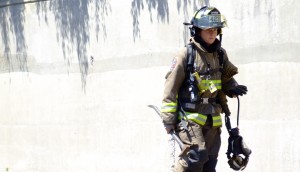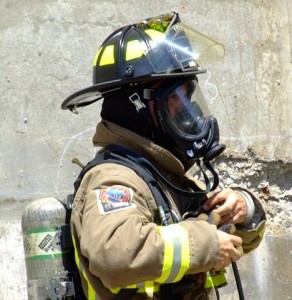If this is your profession, that should scare you.
According to the National Fire Protection Agency in a 3-year period, there were an estimated annual average of 40, 270 firefighter fireground injuries in the U.S. Of these injuries, 24% were attributed to minor sprains/strains, 12% to pain and 34% moderate to severe sprains/strains (1). This accounts for a whopping 70% of total fireground injuries reported!
Since the job requirements are likely fairly similar, it’s not hard to imagine these injury percentages being equivalent here in Canada.
As a firefighter, what does that mean to you?
Quite simply, firefighting is a high risk, dangerous profession!
These types of injuries can cause all sorts of problems, both personally and professionally.
- Lost time at work
- Inability to safely complete physical job requirements
- Placement on modified duties
- Risk of further injury or disability
- Challenges with everyday tasks such as playing with kids, exercising
- Drop in morale and confidence
- Increased rates of frustration, depression due to pain and dysfunction
So what can you do to protect yourself?
In our opinion, there are two things you can do to put yourself in the best possible position to have not only a long, safe career as a fire fighting professional, but also a healthy life outside of work as well.
“An ounce of prevention is worth a pound of cure”
The first item is simply represented by the quote above. This means decreasing your risk before you get hurt. This means doing all you can to make sure your body is in the best possible position to tolerate the rigors of your specific work tasks: that your shoulders and rotator cuff are strong enough to pull heavy hoses, that your legs can tolerate repeatedly climbing ladders in full gear, that your back and core are tough enough to withstand crawling through dangerous terrain, or smashing down walls.
Research has shown that having your body conditioned by improving certain fitness factors, much like a professional athlete, will allow you to perform safely at the highest levels possible, with the lowest risk of injury (2, 3).
These factors include:
- Improving your cardiovascular fitness and stamina to buffer against thermal stress
- Augmenting anaerobic capacity, allowing you to perform bursts of high intensity work such as breaking down walls and doors
- Bolstering muscular strength and endurance to help you lift, carry, and drag anything you need to, with greater ease and less strain on your body
- Optimizing core strength to protect your back against potentially harmful job-specific movement patterns
- Maximize shoulder stability to avoid disastrous rotator cuff or shoulder injuries
By addressing these important fitness factors before you’re injured and increasing your body’s capacity to tolerate profession-specific stresses in a preventative fashion, you can avoid the unnecessary aggravation and pain of common firefighter sprain/strain injuries to your shoulders and rotator cuff, your neck, your back (upper/lower), or your knees and legs. Your workplace benefits package may cover treatments with highly trained physiotherapists and chiropractors who possess specialized knowledge of your job-specific needs, so be smart – Think prevention, not rehabilitation
“You don’t fix the problem until you define it” John W Snow
Secondly, it’s imperative to treat and rehabilitate your existing injuries properly the first time. This means not just dealing with symptoms and giving you a band-aid solution. These only work superficially, but don’t really fix the problem. Proper treatment and rehab should first involve a comprehensive and thorough assessment to find out the underlying causes and risk factors relating to your injury and it should include a complete treatment plan which addresses them in a task specific, functional manner.
Let’s use the example of a firefighter with low back pain. An assessment would look at the typical positions or movements this individual is exposed to throughout the day:
- Do they slouch?
- Do they bend or twist through their back too much?
- Do they bend forward and backward repeatedly?
- Do they twist and turn through the wrong parts of the spine?
During treatment, specific exercises or interventions would be implemented to reduce pain, address problem areas, and protect against further injury. These can include:
- Postural corrections
- Hip mobility drills
- Core strengthening exercises
- Functional retraining
This comprehensive assessment and treatment approach not only treats your injury, it also improves your performance. Not as an afterthought. Not as an aside. But as an integral part of your rehabilitation program.
At Primal Human Performance, we’re focused on specialized treatment for emergency service professionals. Our practitioners, using a variety of specialized assessment, treatment, and therapy techniques, can diagnose your problem and trace it back to the root causes. From here, we will design and implement an individualized treatment plan that will not only deal with the causes of your injury and get you out of pain, but also take your performance to the next level in the shortest time possible.
Yours in Optimal Health,
Dev Chengkalath, Physiotherapist and Katie Au, Chiropractor
References:
(1) Patterns of firefighter fireground injuries. Karter, MJ. National Fire Protection Association, Fire Analysis and Research Division. May 2009.
(2) Curr Sports Med Rep. 2011 May-Jun;10(3):167-72. Firefighter fitness: improving performance and preventing injuries and fatalities. Smith DL.
(3) J Occup Environ Med. 2010 Mar;52(3):336-9. Implementation of a physician-organized wellness regime (POWR) enforcing the 2007 NFPA standard 1582: injury rate reduction and associated cost savings. Leffer M, Grizzell T.




(inside Peak Performance Golf)